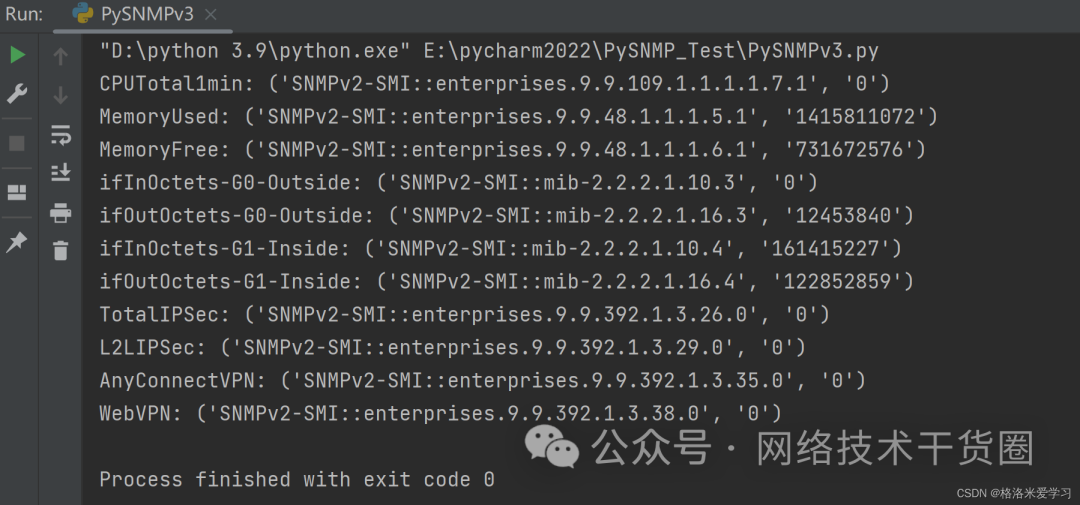一、PySNMP模塊介紹:
PySNMP 是一個跨平臺的純Python SNMP 引擎實現。它具有功能齊全的 SNMP 引擎,能夠充當代理/管理器/代理角色,通過 IPv4/IPv6 和其他網絡傳輸傳輸 SNMP v1/v2c/v3 協議版本。目前,使用較多的是SNMP v3和v2c版本。三個版本的區別如下:
SNMPv1:SNMP的第一個版本,它提供了一種監控和管理計算機網絡的系統方法,它基于團體名認證,安全性較差,且返回報文的錯誤碼也較少。它在RFC 1155和RFC 1157中定義。
SNMPv2c:第二個版本SNMPv2c引入了GetBulk和Inform操作,支持更多的標準錯誤碼信息,支持更多的數據類型。它在RFC 1901,RFC 1905和RFC 1906中定義。
SNMPv3:鑒于SNMPv2c在安全性方面沒有得到改善,IETF頒布了SNMPv3版本,提供了基于USM(User Security Module)的認證加密和基于VACM(View-based Access Control Model)的訪問控制,是迄今為止最安全的版本。SNMPv3在RFC 1905,RFC 1906,RFC 2571,RFC 2572,RFC 2574和RFC 2575中定義。
模塊官網地址:
https://pysnmp.readthedocs.io/en/latest/
二、SNMP v2c實驗
實驗目的: 通過PySNMP Version 4.4.12 SNMP v2c收集Cisco ASAv防火墻的各項指標。
實驗設備: ASAv 992,IP地址10.1.102.254。
實驗步驟:
首先對ASAv設備進行初始化配置:
interfaceGigabitEthernet0/0 nameifinside security-level100 ipaddress10.1.102.254255.255.255.0 noshutdown
接下來配置SNMPv2,允許來自inside區域的10.1.1.1設備進行SNMP訪問,只讀community值為tcpipro。
snmp-serverenable snmp-serverhostinside10.1.1.1communitytcpipro snmp-servercommunitytcpipro
配置完成后,通過如下Python代碼進行測試:
frompysnmp.hlapiimport* defsnmpv2_get(ip,community,oid,port=161): #varBinds是列表,列表中的每個元素的類型是ObjectType(該類型的對象表示MIBvariable) errorindication,errorstatus,errorindex,varbinds=next( getCmd(SnmpEngine(), CommunityData(community),#配置community UdpTransportTarget((ip,port)),#配置目的地址和端口號 ContextData(), ObjectType(ObjectIdentity(oid))#讀取的OID ) ) #錯誤處理 iferrorindication: print(errorindication) eliferrorstatus: print('%sat%s'%( errorstatus, errorindexandvarbinds[int(errorindex)-1][0]or'?' ) ) #如果返回結果有多行,需要拼接后返回 result="" forvarBindinvarbinds: result=result+varBind.prettyPrint()#返回結果! #返回的為一個元組,OID與字符串結果 returnresult.split("=")[0].strip(),result.split("=")[1].strip() if__name__=="__main__": ASA_oid={"CPUTotal1min":"1.3.6.1.4.1.9.9.109.1.1.1.1.7.1","MemoryUsed":"1.3.6.1.4.1.9.9.48.1.1.1.5.1", "MemoryFree":"1.3.6.1.4.1.9.9.48.1.1.1.6.1","ifInOctets-G0-Outside":"1.3.6.1.2.1.2.2.1.10.3", "ifOutOctets-G0-Outside":"1.3.6.1.2.1.2.2.1.16.3","ifInOctets-G1-Inside":"1.3.6.1.2.1.2.2.1.10.4", "ifOutOctets-G1-Inside":"1.3.6.1.2.1.2.2.1.16.4","TotalIPSec":"1.3.6.1.4.1.9.9.392.1.3.26.0", "L2LIPSec":"1.3.6.1.4.1.9.9.392.1.3.29.0","AnyConnectVPN":"1.3.6.1.4.1.9.9.392.1.3.35.0", "WebVPN":"1.3.6.1.4.1.9.9.392.1.3.38.0"} forkey,valueinASA_oid.items(): try: print(key+':',snmpv2_get("10.1.102.254","tcpipro",value)) exceptExceptionase: print(e)
Tips:要獲取特定 ASA 的受支持 SNMP MIB 和 OID 的列表,請輸入以下命令:show snmp-server oidlist進行查看。或者,我們可以通過一些SNMP測試軟件進行查詢,例如ByteSphere OidView。最終python測試結果如圖1所示:

圖1 SNMP v2c測試結果
三、SNMP v3實驗
實驗目的: 通過PySNMP的SNMP v3收集Cisco ASAv防火墻的各項指標。
實驗設備: ASAv 992,IP地址10.1.102.254。
實驗步驟:
完成ASA接口初始化配置后,進行SNMP v3的配置,如下所示:
snmp-serverenable snmp-servergroupsnmpgroupv3priv snmp-serveruseradminsnmpgroupv3authshaCisc0123privaes256Cisc0123 snmp-serverhostinside10.1.1.1version3admin
SNMP v3配置中需要注意的是,首先我們創建了一個SNMP v3認證group snmpgroup,在這個group的用戶數據需要同時進行身份驗證和加密(priv)。其中,auth 關鍵字可啟用數據包身份驗證。noauth 關鍵字表示未在使用數據包身份驗證或加密。priv 關鍵字可啟用數據包加密和身份驗證。auth 或 priv 關鍵字不存在默認值。
接下來,我們在該組內創建了用戶admin,使用的SHA作為哈希算法,密鑰是Cisc0123;加密算法則使用的是AES256,密鑰同樣是Cisc0123。最后,與SNMP v2c相似,我們需要配置允許inside區域10.1.1.1 IP地址的admin用戶使用SNMP v3訪問該ASA設備。
完成SNMP v3配置后,我們可以通過如下SNMPv3 Python代碼進行測試:
frompysnmp.hlapiimport*
defsnmpv3_get(ip,oid,username,authkey,privkey,authprotocol,privprotocol,port=161):
#通過數字映射,對應SNMPv3使用的認證和加密算法
auth_map={'0':usmNoAuthProtocol,'1':usmHMACSHAAuthProtocol,'2':usmHMAC128SHA224AuthProtocol,
'3':usmHMAC192SHA256AuthProtocol,'4':usmHMAC256SHA384AuthProtocol,
'5':usmHMAC384SHA512AuthProtocol}
priv_map={'0':usmNoPrivProtocol,'1':usmAesCfb128Protocol,
'2':usmAesCfb192Protocol,'3':usmAesCfb256Protocol}
#varBinds是列表,列表中的每個元素的類型是ObjectType(該類型的對象表示MIBvariable)
errorindication,errorstatus,errorindex,varbinds=next(
getCmd(SnmpEngine(),
UsmUserData(userName=username,authKey=authkey,privKey=privkey,
authProtocol=auth_map.get(authprotocol),
privProtocol=priv_map.get(privprotocol)),
UdpTransportTarget((ip,port)),#配置目的地址和端口號
ContextData(),
ObjectType(ObjectIdentity(oid))#讀取的OID
)
)
#錯誤處理
iferrorindication:
print(errorindication)
eliferrorstatus:
print('%sat%s'%(
errorstatus,
errorindexandvarbinds[int(errorindex)-1][0]or'?'
)
)
#如果返回結果有多行,需要拼接后返回
result=""
forvarBindinvarbinds:
result=result+varBind.prettyPrint()#返回結果!
#返回的為一個元組,OID與字符串結果
returnresult.split("=")[0].strip(),result.split("=")[1].strip()
if__name__=="__main__":
ASA_oid={"CPUTotal1min":"1.3.6.1.4.1.9.9.109.1.1.1.1.7.1","MemoryUsed":"1.3.6.1.4.1.9.9.48.1.1.1.5.1",
"MemoryFree":"1.3.6.1.4.1.9.9.48.1.1.1.6.1","ifInOctets-G0-Outside":"1.3.6.1.2.1.2.2.1.10.3",
"ifOutOctets-G0-Outside":"1.3.6.1.2.1.2.2.1.16.3","ifInOctets-G1-Inside":"1.3.6.1.2.1.2.2.1.10.4",
"ifOutOctets-G1-Inside":"1.3.6.1.2.1.2.2.1.16.4","TotalIPSec":"1.3.6.1.4.1.9.9.392.1.3.26.0",
"L2LIPSec":"1.3.6.1.4.1.9.9.392.1.3.29.0","AnyConnectVPN":"1.3.6.1.4.1.9.9.392.1.3.35.0",
"WebVPN":"1.3.6.1.4.1.9.9.392.1.3.38.0"}
forkey,valueinASA_oid.items():
try:
print(key+':',snmpv3_get("10.1.102.254",value,'admin','Cisc0123','Cisc0123','1','3'))
exceptExceptionase:
print(e)
需要注意的是,這里我們對SNMP v3的加密和HASH算法進行了映射,后續只需要傳入相關的數字編號,即可設置SNMP v3的安全參數。最終的測試結果如圖2所示:
審核編輯:劉清
-
SNMP
+關注
關注
0文章
85瀏覽量
29744 -
python
+關注
關注
56文章
4792瀏覽量
84628 -
Hash算法
+關注
關注
0文章
43瀏覽量
7382
原文標題:高級網絡工程師必備技能:使用Python PySNMP模塊獲取設備指標
文章出處:【微信號:網絡技術干貨圈,微信公眾號:網絡技術干貨圈】歡迎添加關注!文章轉載請注明出處。
發布評論請先 登錄
相關推薦




 如何使用Python PySNMP模塊獲取設備指標呢?
如何使用Python PySNMP模塊獲取設備指標呢?












評論